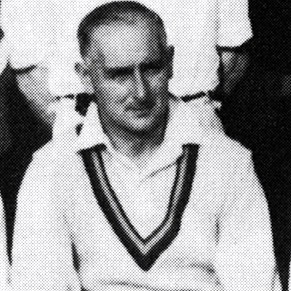
In another of our “Down Memory Lane” milestones we look back 75 years to 1941 and the arrival of the 1st Battalion Green Howards in Ulster.
At the time the Province was inundated with American and British troops and while the Yanks lamented the absence of baseball, the Green Howards took to the cricket grounds of Ulster like ducks to water. Inspired by their Commanding Officer Colonel Alan Shaw, the Battalion always travelled with their cricket gear, and within their ranks they had two of the finest players in the history of English cricket.
Hedley Verity and Norman Yardley were already household names when the war broke out in 1939. They were both on the Yorkshire team that hammered Sussex at Hove in the last county game before the championship was abandoned for the duration of the war. Yardley and Len Hutton scored centuries, but it was Verity who created havoc with 7-9 in six mercurial overs on a rain-affected track.
Although they didn’t know it at the time, it was the great spinner’s last 1st Class match.
Hedley Verity was a lovely man, and he captured the hearts of many Ulster people during his three months stay. The battalion had barely arrived when scouts were despatched all around Omagh to find a suitable cricket ground. They finally located a small bouncy pitch within the grounds of the Tyrone and Fermanagh Mental Hospital, thanks to the good offices of Dr. Moore Johnston. Little “Headingley” was quickly created with loving care, and the Green Howards cricket team soon took the field against all and sundry. Colonel Shaw loved his cricket, and in due course the team travelled all over the Province to play in exhibition matches. Verity and Yardley were the big draws, and cricket lovers were always delighted to welcome the two world-class players to their grounds.
Strabane Cricket Club jumped at the opportunity and made the most of their nomadic guests. All the Green Howards cricketers were made promptly honorary members, and at the end of the season military personnel dominated their batting and bowling averages. But the cream on the cake was a memorable North-West league and cup double, in a season that club stalwarts still feel was their best ever. In their first match at Sion Mills Yardley scored 57 and Verity took 6-62, a double act that was to be repeated on many grounds that summer.
During the war years a lot of cricket was played to raise funds for the war effort. The matches featured a number of county players and the best players in the Province lined up against the visiting celebrities. The Province of Ulster played the Army at Ormeau in July when Bill Lowdnes captained the military team and George Crothers the Ulster team. In one match at Muckamore organized by the Sherwood Forresters, David Pigot and Jimmy Boucher travelled from Dublin by train to play.
Military duties permitting, the army cricketers played wherever and whenever they could. They visited Derry, Armagh, Omagh, Strabane, Belfast, Waringstown, Muckamore and Lisburn amongst others. No team entered into the spirit of the sport more than the Green Howards, so it was with much regret and sadness that they left the Province at the end of the summer for a more sombre calling. In due course the news filtered back to Ulster of casualties, and amongst them the great Hedley Verity.
Hedley died from fatal wounds received in crossfire in 1943 after being trapped in a canefield at Catania in Sicily. Norman Yardley was wounded in the Western Desert, but recovered to rekindle his cricket career with great success in the post-war era. He never forgot his summer in Ulster, or his Yorkshire colleague, and once wrote;
“I have many happy recollections of playing cricket at Armagh, Londonderry and Strabane amongst others. Our Commanding Officer Lieut. Col. AL Shaw was a cricket fanatic, and also a very good batsman, who once played for a representative team against the MCC captained by DR Jardine in India in 1934. Also, of course, the great Hedley Verity, sadly killed in action, so together with some good club cricketers, we had an attractive side and had no difficulty in landing opponents.”








